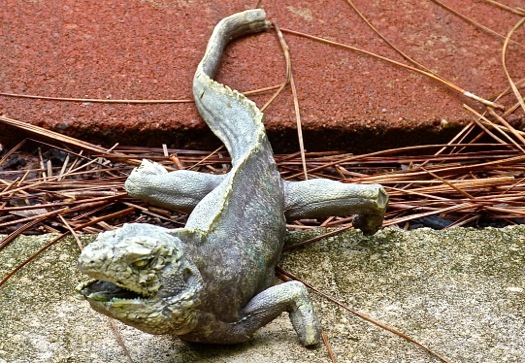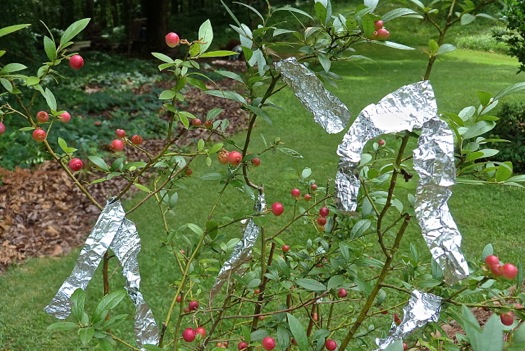"No, you don't!"
Earlier this week I walked outside to see a chickadee on a tomato plant and a cardinal on a blueberry plant. More birds were waiting in nearby trees to see what happened to the reconnaissance team.
I have over three acres of land with many trees and shrubs planted specifically with the birds in mind. In fact, not far from my vegetable garden are two serviceberry (Amelanchier) trees with berries that taste much like blueberries. The birds are welcome to them. Also, earthworms and many tasty bugs thrive in soil that has been improved with rich organic mulch and compost. These critters provide a hearty meal to any hungry bird.
But my veggies and blueberries are off limits.
It was time to do something about it. Pronto. I shooed the birds away and thought about the problem. I had a couple of ideas.
First, I retrieved my old rubber lizard from the front garden and put him on the path that separates the tomatoes from the blueberries. This very old rubber lizard has been gnawed by dogs and tossed around by children. The dogs are long buried and the children are grown. But for all his chewed and missing body parts, I am still fond of him and he has a welcome spot in the garden.He is a scary creature, and I hoped any bird would be afraid of him. But in case the lizard wasn't enough to deter my flying friends, I had another plan to foil the birds.
This very old rubber lizard has been gnawed by dogs and tossed around by children. The dogs are long buried and the children are grown. But for all his chewed and missing body parts, I am still fond of him and he has a welcome spot in the garden.He is a scary creature, and I hoped any bird would be afraid of him. But in case the lizard wasn't enough to deter my flying friends, I had another plan to foil the birds.
I cut thin strips of aluminum foil and wrapped them around branches of the tomatoes and blueberries, very much like icicles on a Christmas tree. I think lots of shiny foil flapping in the breeze should intimidate any bird. Lou looked at my garden full of fluttering strips of tin foil and told me it reminded him of the science fiction movie "Signs," in which the main characters used aluminum foil hats to keep aliens from reading their minds.
Lou looked at my garden full of fluttering strips of tin foil and told me it reminded him of the science fiction movie "Signs," in which the main characters used aluminum foil hats to keep aliens from reading their minds.
It is working. So far neither birds nor aliens have eaten any more of my tomatoes or blueberries. Though truthfully I can't say for sure if it is the lizard or the aluminum foil that is more effective. What do you think?
For a refreshing interlude from summer heat and to get another look at the lizard, you may also enjoy this post: A Snowy Monster and Other Things in My Garden